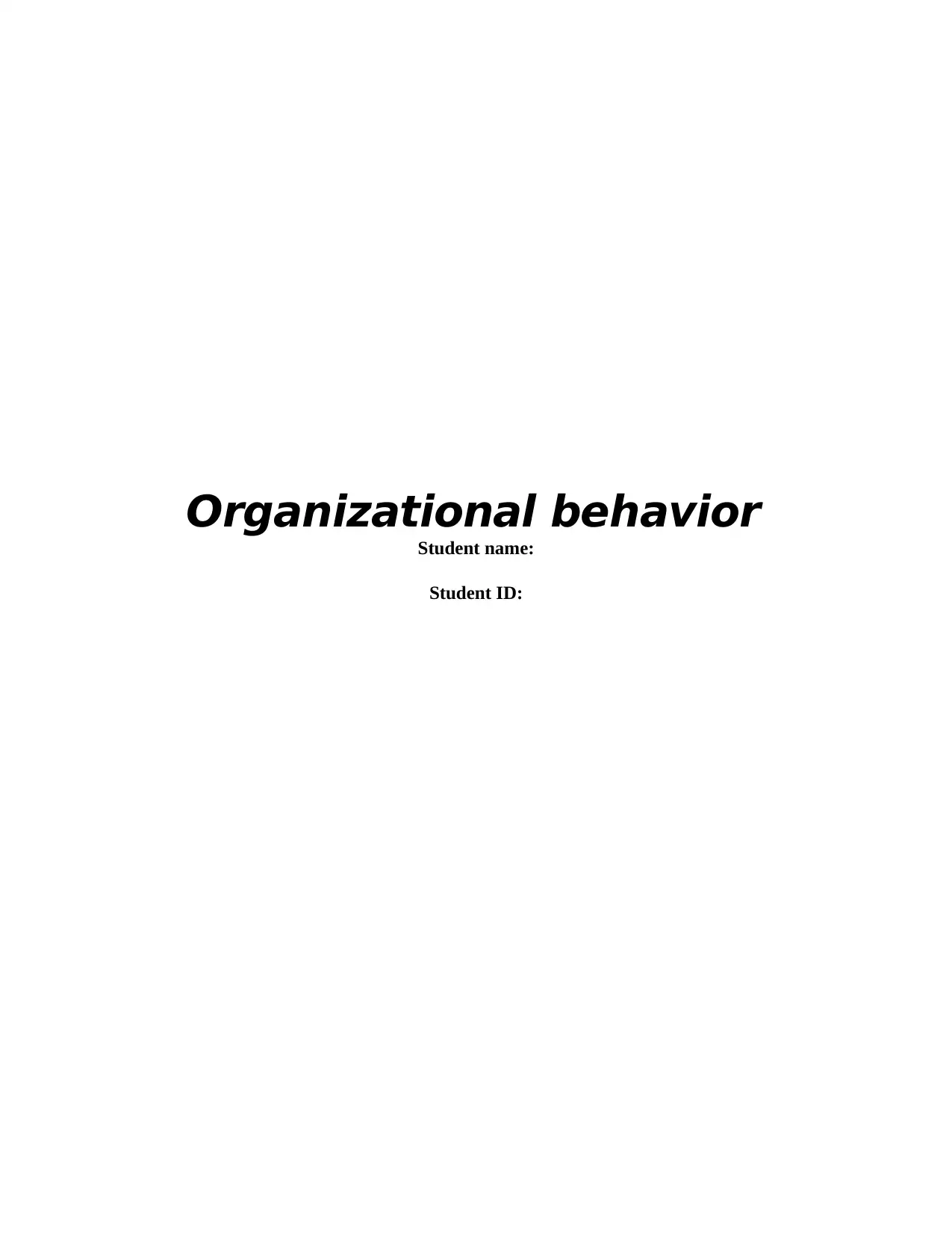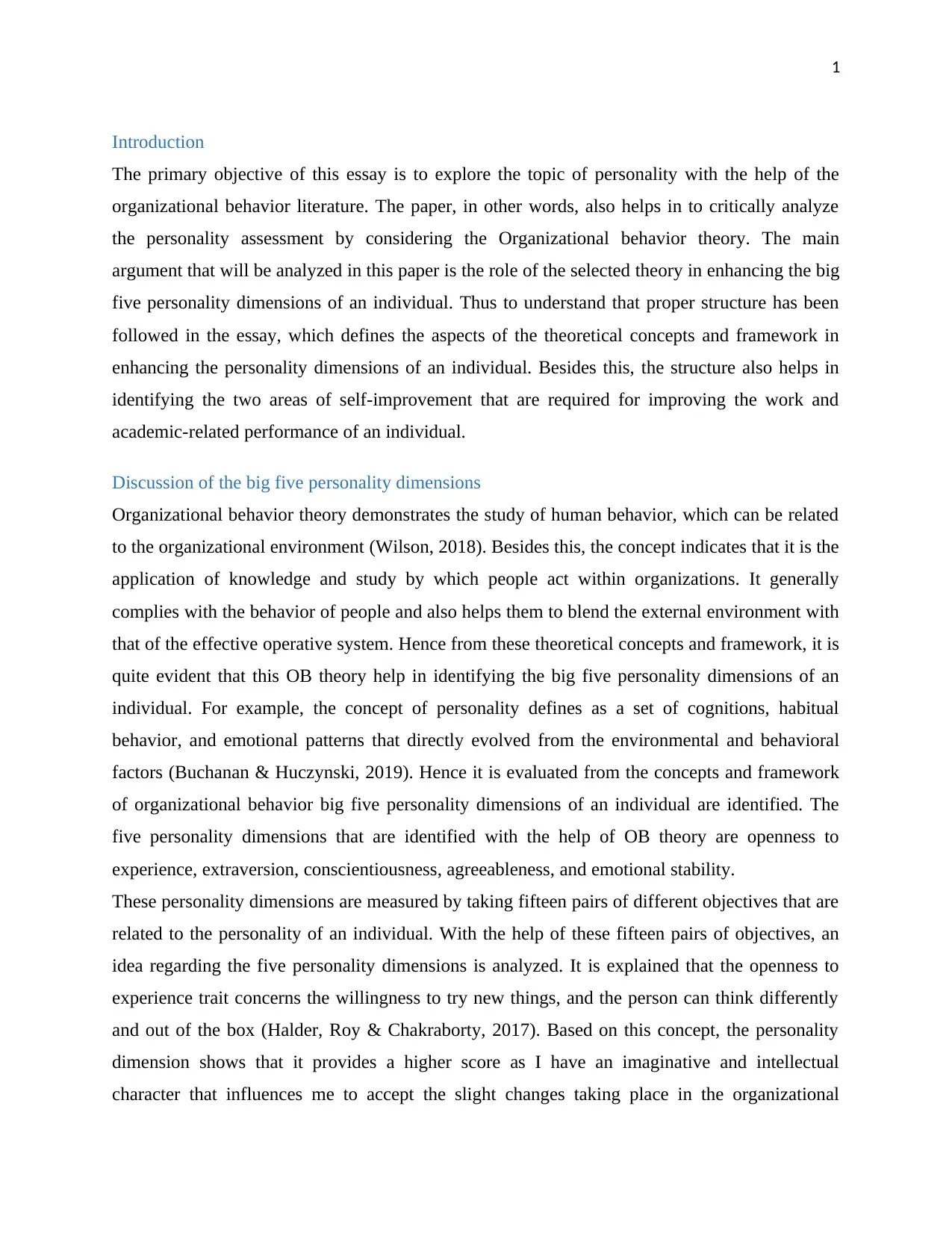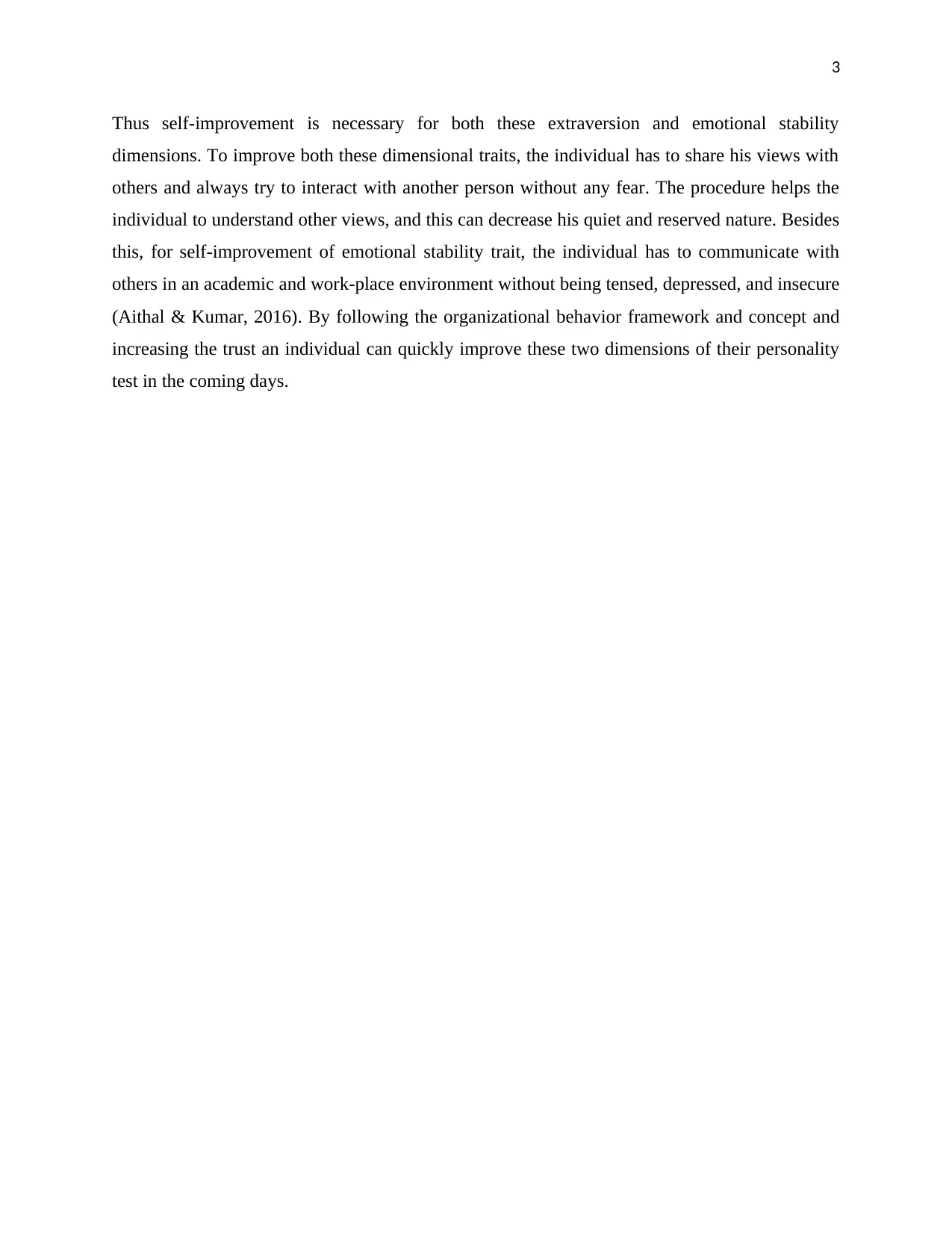Critical Analysis of Personality Dimensions in Organizational Behavior
VerifiedAdded on 2022/09/12
|7
|1555
|12
Essay
AI Summary
This essay critically examines the topic of personality through the lens of organizational behavior theory. It begins with an introduction outlining the essay's structure and argument, which centers on the role of the "Big Five" personality dimensions in individual behavior within an organizational context. The essay then delves into a detailed discussion of these five dimensions: openness to experience, conscientiousness, extraversion, agreeableness, and emotional stability, supported by relevant organizational behavior theories and literature. The analysis includes examples and the application of the Big Five personality test results to identify two areas for self-improvement. These areas, extraversion and emotional stability, are discussed in terms of how they can be enhanced to improve both academic and work-related performance. The essay concludes by summarizing the key points, emphasizing the connection between personality dimensions and organizational behavior, and highlighting the importance of self-improvement for better future outcomes.

Organizational behavior
Student name:
Student ID:
Student name:
Student ID:
Paraphrase This Document
Need a fresh take? Get an instant paraphrase of this document with our AI Paraphraser

1
Introduction
The primary objective of this essay is to explore the topic of personality with the help of the
organizational behavior literature. The paper, in other words, also helps in to critically analyze
the personality assessment by considering the Organizational behavior theory. The main
argument that will be analyzed in this paper is the role of the selected theory in enhancing the big
five personality dimensions of an individual. Thus to understand that proper structure has been
followed in the essay, which defines the aspects of the theoretical concepts and framework in
enhancing the personality dimensions of an individual. Besides this, the structure also helps in
identifying the two areas of self-improvement that are required for improving the work and
academic-related performance of an individual.
Discussion of the big five personality dimensions
Organizational behavior theory demonstrates the study of human behavior, which can be related
to the organizational environment (Wilson, 2018). Besides this, the concept indicates that it is the
application of knowledge and study by which people act within organizations. It generally
complies with the behavior of people and also helps them to blend the external environment with
that of the effective operative system. Hence from these theoretical concepts and framework, it is
quite evident that this OB theory help in identifying the big five personality dimensions of an
individual. For example, the concept of personality defines as a set of cognitions, habitual
behavior, and emotional patterns that directly evolved from the environmental and behavioral
factors (Buchanan & Huczynski, 2019). Hence it is evaluated from the concepts and framework
of organizational behavior big five personality dimensions of an individual are identified. The
five personality dimensions that are identified with the help of OB theory are openness to
experience, extraversion, conscientiousness, agreeableness, and emotional stability.
These personality dimensions are measured by taking fifteen pairs of different objectives that are
related to the personality of an individual. With the help of these fifteen pairs of objectives, an
idea regarding the five personality dimensions is analyzed. It is explained that the openness to
experience trait concerns the willingness to try new things, and the person can think differently
and out of the box (Halder, Roy & Chakraborty, 2017). Based on this concept, the personality
dimension shows that it provides a higher score as I have an imaginative and intellectual
character that influences me to accept the slight changes taking place in the organizational
Introduction
The primary objective of this essay is to explore the topic of personality with the help of the
organizational behavior literature. The paper, in other words, also helps in to critically analyze
the personality assessment by considering the Organizational behavior theory. The main
argument that will be analyzed in this paper is the role of the selected theory in enhancing the big
five personality dimensions of an individual. Thus to understand that proper structure has been
followed in the essay, which defines the aspects of the theoretical concepts and framework in
enhancing the personality dimensions of an individual. Besides this, the structure also helps in
identifying the two areas of self-improvement that are required for improving the work and
academic-related performance of an individual.
Discussion of the big five personality dimensions
Organizational behavior theory demonstrates the study of human behavior, which can be related
to the organizational environment (Wilson, 2018). Besides this, the concept indicates that it is the
application of knowledge and study by which people act within organizations. It generally
complies with the behavior of people and also helps them to blend the external environment with
that of the effective operative system. Hence from these theoretical concepts and framework, it is
quite evident that this OB theory help in identifying the big five personality dimensions of an
individual. For example, the concept of personality defines as a set of cognitions, habitual
behavior, and emotional patterns that directly evolved from the environmental and behavioral
factors (Buchanan & Huczynski, 2019). Hence it is evaluated from the concepts and framework
of organizational behavior big five personality dimensions of an individual are identified. The
five personality dimensions that are identified with the help of OB theory are openness to
experience, extraversion, conscientiousness, agreeableness, and emotional stability.
These personality dimensions are measured by taking fifteen pairs of different objectives that are
related to the personality of an individual. With the help of these fifteen pairs of objectives, an
idea regarding the five personality dimensions is analyzed. It is explained that the openness to
experience trait concerns the willingness to try new things, and the person can think differently
and out of the box (Halder, Roy & Chakraborty, 2017). Based on this concept, the personality
dimension shows that it provides a higher score as I have an imaginative and intellectual
character that influences me to accept the slight changes taking place in the organizational

2
environment. Besides this, the term conscientiousness demonstrates the tendency of a person
having controlling impulses and acting socially and also possess a goal-oriented behavior
(Hassan, Asad & Hoshino, 2016).
The objectives show that I am a very responsible, achievement-oriented, and slightly dependable
person, and this also provides an average high score in this dimension. The third traits of
extraversion demonstrate the ability of an individual to interact with others (Presbitero, 2016).
Hence by following this characteristic, I have noticed that I mostly prefer to be alone, reserved,
and quiet. Thus the presence of such characters provides me a lower score in these personality
dimensions. The agreeableness traits demonstrate the pursuit of interactions as well as the
orientation of individuals with others. The attributes generally explain the concern of people
while interacting with others in both work and life context (Debusscher, Hofmans & De Fruyt,
2016). Thus based on this fact, it is analyzed that I have a co-operative and trusting nature, which
allows me to interact with the people surrounding in the environment effectively.
Nature and responsible character thus allow me to score good marks in these personality
dimensions. The emotional stability dimension, in other words, provides me a lower score
because when interacting with someone in the organization or another place, sometimes I feel
tense, depressed, and insecure regarding their topic of discussion. Hence these are the five
personality dimensions and their test results, and all these traits show that it depends on the
characteristics as well as the behavior of an individual (Buchanan & Huczynski, 2019). Thus
after reviewing this concept, it is quite evident that the organizational behavior theory indirectly
related to the personality dimensions of an individual.
Utilization of OB theory and identification of performance improvement areas
The results generated from the big five personality dimensions test demonstrate the strong and
weak areas of my personality. According to the organizational behavioral theory, the personality
of an individual can be developed after investigating the behavior, emotions, and performances
in a team or as an individual in the workplace (Ismail, Ashfaq, Panatik, Jaes & Yan, 2018).
Based on the personality traits, I have assumed that for improving my organizational behavior, I
have enhanced my level of understanding of two different dimensions. From the results, it is
analyzed that I have gained higher scores in openness to experience, conscientiousness and
agreeableness traits, and lower scores in extraversion and emotional stability traits.
environment. Besides this, the term conscientiousness demonstrates the tendency of a person
having controlling impulses and acting socially and also possess a goal-oriented behavior
(Hassan, Asad & Hoshino, 2016).
The objectives show that I am a very responsible, achievement-oriented, and slightly dependable
person, and this also provides an average high score in this dimension. The third traits of
extraversion demonstrate the ability of an individual to interact with others (Presbitero, 2016).
Hence by following this characteristic, I have noticed that I mostly prefer to be alone, reserved,
and quiet. Thus the presence of such characters provides me a lower score in these personality
dimensions. The agreeableness traits demonstrate the pursuit of interactions as well as the
orientation of individuals with others. The attributes generally explain the concern of people
while interacting with others in both work and life context (Debusscher, Hofmans & De Fruyt,
2016). Thus based on this fact, it is analyzed that I have a co-operative and trusting nature, which
allows me to interact with the people surrounding in the environment effectively.
Nature and responsible character thus allow me to score good marks in these personality
dimensions. The emotional stability dimension, in other words, provides me a lower score
because when interacting with someone in the organization or another place, sometimes I feel
tense, depressed, and insecure regarding their topic of discussion. Hence these are the five
personality dimensions and their test results, and all these traits show that it depends on the
characteristics as well as the behavior of an individual (Buchanan & Huczynski, 2019). Thus
after reviewing this concept, it is quite evident that the organizational behavior theory indirectly
related to the personality dimensions of an individual.
Utilization of OB theory and identification of performance improvement areas
The results generated from the big five personality dimensions test demonstrate the strong and
weak areas of my personality. According to the organizational behavioral theory, the personality
of an individual can be developed after investigating the behavior, emotions, and performances
in a team or as an individual in the workplace (Ismail, Ashfaq, Panatik, Jaes & Yan, 2018).
Based on the personality traits, I have assumed that for improving my organizational behavior, I
have enhanced my level of understanding of two different dimensions. From the results, it is
analyzed that I have gained higher scores in openness to experience, conscientiousness and
agreeableness traits, and lower scores in extraversion and emotional stability traits.
⊘ This is a preview!⊘
Do you want full access?
Subscribe today to unlock all pages.

Trusted by 1+ million students worldwide

3
Thus self-improvement is necessary for both these extraversion and emotional stability
dimensions. To improve both these dimensional traits, the individual has to share his views with
others and always try to interact with another person without any fear. The procedure helps the
individual to understand other views, and this can decrease his quiet and reserved nature. Besides
this, for self-improvement of emotional stability trait, the individual has to communicate with
others in an academic and work-place environment without being tensed, depressed, and insecure
(Aithal & Kumar, 2016). By following the organizational behavior framework and concept and
increasing the trust an individual can quickly improve these two dimensions of their personality
test in the coming days.
Thus self-improvement is necessary for both these extraversion and emotional stability
dimensions. To improve both these dimensional traits, the individual has to share his views with
others and always try to interact with another person without any fear. The procedure helps the
individual to understand other views, and this can decrease his quiet and reserved nature. Besides
this, for self-improvement of emotional stability trait, the individual has to communicate with
others in an academic and work-place environment without being tensed, depressed, and insecure
(Aithal & Kumar, 2016). By following the organizational behavior framework and concept and
increasing the trust an individual can quickly improve these two dimensions of their personality
test in the coming days.
Paraphrase This Document
Need a fresh take? Get an instant paraphrase of this document with our AI Paraphraser

4
Conclusion
The OB theoretical view defines that human behavior can chance effectively with the changing
of the environment present in the organization. Besides this, personality dimensions demonstrate
the individual differences in the characteristics pattern of feeling, behaving, and thinking. Thus
from this personality dimension concept, it is analyzed that it is relatable with the organizational
behavior theory and framework. The five personality dimensions that are demonstrated in this
context are openness to experience, extraversion, conscientiousness, agreeableness, and
emotional stability. Among the five personality dimensions traits, the paper concludes that the
emotional stability and extraversion dimensions are the traits that should be improved by me for
getting better results in maintaining work and academic performance in the future.
Conclusion
The OB theoretical view defines that human behavior can chance effectively with the changing
of the environment present in the organization. Besides this, personality dimensions demonstrate
the individual differences in the characteristics pattern of feeling, behaving, and thinking. Thus
from this personality dimension concept, it is analyzed that it is relatable with the organizational
behavior theory and framework. The five personality dimensions that are demonstrated in this
context are openness to experience, extraversion, conscientiousness, agreeableness, and
emotional stability. Among the five personality dimensions traits, the paper concludes that the
emotional stability and extraversion dimensions are the traits that should be improved by me for
getting better results in maintaining work and academic performance in the future.

5
References
Aithal, P. S., & Kumar, P. M. (2016). Organizational behaviour in 21st century–'Theory A'for
managing people for performance. IOSR Journal of Business and Management (IOSR-
JBM), 18(7), 126-134.
Buchanan, D. A., & Huczynski, A. A. (2019). Organizational behaviour. Pearson UK.
Debusscher, J., Hofmans, J., & De Fruyt, F. (2016). The effect of state core self-evaluations on
task performance, organizational citizenship behaviour, and counterproductive work
behaviour. European Journal of Work and Organizational Psychology, 25(2), 301-315.
Halder, S., Roy, A., & Chakraborty, P. K. (2017). The influence of personality traits on
information seeking behaviour of students. Malaysian Journal of Library & Information
Science, 15(1), 41-53.
Hassan, H., Asad, S., & Hoshino, Y. (2016). Determinants of leadership style in big five
personality dimensions. universal journal of management, 4(4), 161-179.
Ismail, F., Ashfaq, M., Panatik, S. A., Jaes, L., & Yan, W. M. (2018). The Relationship Between
Big Five Personality Traits and Counterproductive Work Behaviour. International
Journal of Engineering & Technology, 7(3.30), 63-65.
Presbitero, A. (2016). Cultural intelligence (CQ) in virtual, cross-cultural interactions:
Generalizability of measure and links to personality dimensions and task
performance. International Journal of Intercultural Relations, 50, 29-38.
Wilson, F. M. (2018). Organizational behaviour and work: a critical introduction. Oxford
university press.
References
Aithal, P. S., & Kumar, P. M. (2016). Organizational behaviour in 21st century–'Theory A'for
managing people for performance. IOSR Journal of Business and Management (IOSR-
JBM), 18(7), 126-134.
Buchanan, D. A., & Huczynski, A. A. (2019). Organizational behaviour. Pearson UK.
Debusscher, J., Hofmans, J., & De Fruyt, F. (2016). The effect of state core self-evaluations on
task performance, organizational citizenship behaviour, and counterproductive work
behaviour. European Journal of Work and Organizational Psychology, 25(2), 301-315.
Halder, S., Roy, A., & Chakraborty, P. K. (2017). The influence of personality traits on
information seeking behaviour of students. Malaysian Journal of Library & Information
Science, 15(1), 41-53.
Hassan, H., Asad, S., & Hoshino, Y. (2016). Determinants of leadership style in big five
personality dimensions. universal journal of management, 4(4), 161-179.
Ismail, F., Ashfaq, M., Panatik, S. A., Jaes, L., & Yan, W. M. (2018). The Relationship Between
Big Five Personality Traits and Counterproductive Work Behaviour. International
Journal of Engineering & Technology, 7(3.30), 63-65.
Presbitero, A. (2016). Cultural intelligence (CQ) in virtual, cross-cultural interactions:
Generalizability of measure and links to personality dimensions and task
performance. International Journal of Intercultural Relations, 50, 29-38.
Wilson, F. M. (2018). Organizational behaviour and work: a critical introduction. Oxford
university press.
⊘ This is a preview!⊘
Do you want full access?
Subscribe today to unlock all pages.

Trusted by 1+ million students worldwide

6
Appendix
Big five personality dimensions
Instructions
Student name
Student Number
Workshop day/time
15 pairs of objectives for big five personality test
1 Quiet Talkative
2 Tolerant Critical
3 Disorganized Organized
4 Tense Calm
5 Imaginative Conventional
6 Reserved Outgoing
7 Uncooperative Cooperative
8 Unreliable Dependable
9 Insecure Secure
10 New Familiar
11 Sociable Loner
12 Suspicious Trusting
13 Undirected Goal-oriented
14 Enthusiastic Depressed
15 Change Status quo
Appendix
Big five personality dimensions
Instructions
Student name
Student Number
Workshop day/time
15 pairs of objectives for big five personality test
1 Quiet Talkative
2 Tolerant Critical
3 Disorganized Organized
4 Tense Calm
5 Imaginative Conventional
6 Reserved Outgoing
7 Uncooperative Cooperative
8 Unreliable Dependable
9 Insecure Secure
10 New Familiar
11 Sociable Loner
12 Suspicious Trusting
13 Undirected Goal-oriented
14 Enthusiastic Depressed
15 Change Status quo
1 out of 7
Related Documents
Your All-in-One AI-Powered Toolkit for Academic Success.
+13062052269
info@desklib.com
Available 24*7 on WhatsApp / Email
![[object Object]](/_next/static/media/star-bottom.7253800d.svg)
Unlock your academic potential
Copyright © 2020–2025 A2Z Services. All Rights Reserved. Developed and managed by ZUCOL.





